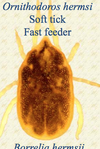Spirochaetes: Borrelia Flashcards
Borrelia is a gram _____ bacteria
Negative
Longer and wider than treponemes
Linear chromosome

Which species of Borrelia causes Lyme disease?
B. burgdorferi
[also B. garnerii and B. afzelii - mentions that these have been ID in the US causing Lyme disease in humans, dogs and horses]
True/False. Borrelia is microaerophilic and an obligate pathogen.
True
Microaerophilic - need oxygen because they cannot ferment or respire anaerobically. However, they are poisoned by high concentrations of oxygen.
Which species of Borrelia causes avian borreliosis?
B. anerina
Which species of Borrelia causes relapsing fever?
B. reccurentis
[Antigenic vairation occurs post-infection at days 4, 7, 14, 21 and 28 and at 7 and 12 months due to selective pressure of antibodies for OSP (outer surface proteins)]
How is Borrelia transmitted?
Arthropod vector - ticks
What is the main virulence factor for Borrelia?
Antigenic variation - major outer surface lipoproteins
[can change based on where its growing - tick or human etc]
Which OSP of B. burgdorferi changes its variation in the midgut of ticks and in culture?
OSP C changes to OSP A
Which OSP of B. burgdorferi changes its variation in the salivary gland of ticks?
OSP A changes OSP C
Which species of ticks transmit B. hermsii? What disese does it cause? Does the blood require a high number or low number of orangisms for infection?
Ornithodoros hermsi (soft tick, fast feeder)
Relapsing fever (also B. recurrentis)
High density in blood for infection

Which OSP of B. burgdorferi is present in mammals early in infection?
OSP C
Which species of ticks transmits B. Burgdorferi? What disease does it transmit? Does the blood require a high number or low number of orangisms for infection?
Ixodes scapularis and Ixodes pacificus (hard tick, slow feeder)
Lyme’s disease
Low denisty in blood for infection

Which tick species transmits Lymes disease in the western US?
Ixodes pacificus

Which tick species transmits Lyme’s disease in the eastern US?
Ixodes scapularis

Which species of ticks maintains a sylvatic infection in the southeast US?
Ixodes affinis
Ixodes minor

Where do the spirochetes of B. burgdorferi multiply in the highest numbers?
Spirochetes multiply to highest numbers in the skin
[then disseminate via the bloodstream]
Which organs are infected in an animal infected with Lyme’s disease?
Organisms spread throughout blood to joints, brain, nerves, eyes, heart, liver and kidney
How long would expect recovery from Lymes disease to take? How would you treat it?
Disease is caused by acute infection; however, full recovery may take months or years after infection resolves due to residual damaging effects of infection
No need for more than a single course of antimicrobial treatment
Which seasons would you expect to see an increased amount of Lymes disease cases?
Spring and summer
What clinical signs would you expect to see in a dog infected with B. Burgdorferi?
Canine lyme disease
Clinical signs: fever, acute arthritis, arthraglia and lamness
(sometimes accompanied by anorexia, lethargy and depression)
[CNS involvment, heart and renal lesions, and uveitis are less frequently reported and not reproduced experimentally in dogs]

Is it difficult to directly detect B. burgdorferi microscopically and on culture? What kind of biopsy would you want to use for the most successful chance of culture?
Yes it is difficult due to small numbers of organism
Greater probability of successful culture from skin biopsy

What technique can you use to distinguish between natural exposure to B. burgdorferi and vaccination?
Western blotting
What is the presumptive diagnosis of Lymes disease based on?
Evidence of exposure to B. burgdorferi
Clinical signs consistent with disease
Consideration of other differentials
Response to treatment
What types of serology tests are you gonna use to diagnose Lymes?
Detection of antibody
Two tiered testing: SNAP test (EIA) plus western blot
SNAP test for point of care testing
Quantitative C6 ELISA - monitor therapy
For dogs and horses: multiplex assay
How would you treat a dog that had clinical signs of Lymes disease, but tested negative?
Don’t treat
Evaluate for underlying disease and retest
How would you treat a dog that was healthy, but tested positives for lymes disease?
Infection is likely (not 100%) subclinical
Treatment preferred in endemic areas (doxycycline)
Treatment in non-endemic areas not pursued
Does the Lyme disease vaccine prevent infection?
No. Reduces incidence of disease in endemic region by ~3%.
Vaccines cause production of OSP A antibodies which will neutralize the organism in the midguy of the tick after a blood meal. OSP A cannot convert to OSP C.


